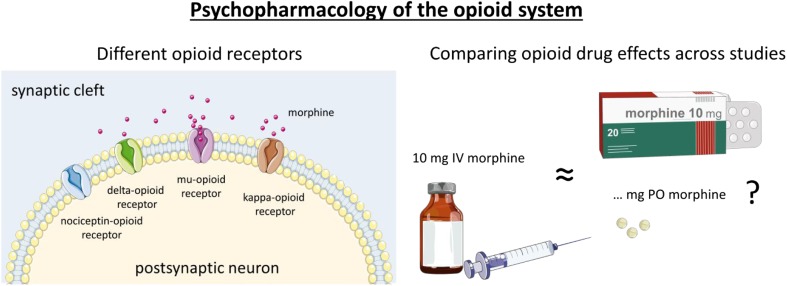Fig. 2.
Left panel: Drugs can affect the opioid system via different receptor subtypes. The opioid system is made up of four different opioid receptor types, the mu-, delta, kappa-, and the nociceptin receptors (Corbett, 2009). Several types of endogenous ligands, such as endorphins, enkephalins, dynorphins, endomorphins, and nociceptin activate these (Calo, Guerrini, Rizzi, Salvadori, & Regoli, 2000; Fichna, Janecka, Costentin, & Do Rego, 2007). Drugs, such as morphine and heroin, are considered mu-opioid agonists, i.e., they act primarily on the mu-opioid receptor (Pasternak, 2001). The drugs that block endogenous opioid signaling (antagonists, such as naloxone or naltrexone) in humans typically inhibit activity at both mu- and kappa-receptors. To date, the mechanism of action of the mu-opioid receptor is best understood. Both the analgesic and the euphoric effects of opioid drugs are thought to be mediated by this receptor type (Fields & Margolis, 2015). Although mu-opioid receptors are widely distributed in the brain (and in other parts of the body as well), they are in particular highly expressed in limbic brain areas, such as the basal ganglia, thalamus, and anterior cingulate. They also are expressed to a moderate extent in cortical areas, such as lateral prefrontal and insular regions (Henriksen & Willoch, 2008). Right panel: Mu-opioid receptors are activated by a large number of different drugs, and they are commonly compared in terms of their efficacy to relieve pain at a particular dose and administration method. Opioid drugs are often given as pills (per oral; PO) but also intravenously (IV), transnasally (TN), subcutaneously (SC), and intramuscularly (IM). We have calculated a rough estimate of “morphine equivalence” on the basis of available evidence of analgesic effects. This conversion was primarily based on the values provided in earlier work (Knotkova, Fine, & Portenoy, 2009; Zacny, 1995). It is important to emphasize that dosages with similar analgesic properties can have different effects on cognitive function, and a simple conversion does not capture the different pharmacokinetics of different drugs. To emphasize that the conversion is coarse for the present purposes, we do not report the exact equianalgesic doses of morphine. Instead, we have categorized the dose as a low, medium, or high dose, using 4 mg and 7 mg IV of morphine as the minimal cutoff values for the medium and high dose, respectively. As for the opioid antagonists, these were categorized on the basis of available PET evidence about the proportion of mu-opioid receptors blocked by a given drug dose (Mayberg & Frost, 1990). Doses covering 90-100% of receptors are considered full antagonists (Weerts et al., 2013). Where doses administered were much higher or lower than this range, this is specified in the text. In addition to drugs acting primarily as agonists or antagonist to opioid receptors, the literature also contains several reports from “mixed agonists,” i.e., drugs that act simultaneously as agonists and antagonists at different opioid receptors (Jacob, Michaud, & Tremblay, 1979). This category also covers drugs that act as partial agonists and antagonists, such as buprenorphine, which binds strongly to mu-opioid receptors, but causes less activation of the receptor than the endogenous ligand. Buprenorphine is also a kappa-opioid antagonist. These drugs were also categorized on the basis of their analgesic effects at the doses used in the literature. Figures were produced with graphics from Servier Medical Art (smart.servier.com) under Creative Commons BY 3.0 license.

